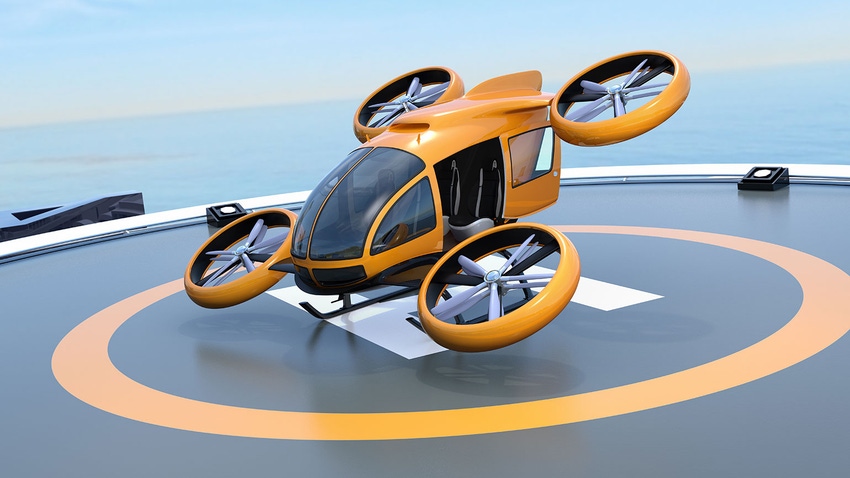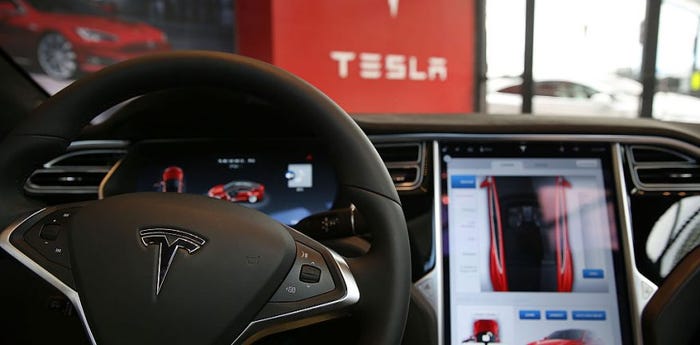5 Considerations Before Flying Taxis Take Flight
Companies like Uber are working to commercialize the flying taxi. We take a look at the factors that could enable or hinder such craft from achieving liftoff in the near term.
January 28, 2019

Uber is promising that flying cars are “closer than you think,” as a 2017 commercial spot for a forthcoming flying-car service put it. The company isn’t alone in that sentiment. At CES this year, Uber Elevate partner Bell unveiled a prototype for its Nexus vertical-takeoff-and-landing aircraft. And another Uber Elevate partner, Boeing, recently completed a test of its PAV, or passenger air vehicle. Other companies ranging from startups like AeroMobil to well-known companies such as Airbus and Audi to Rolls Royce have joined the effort to make the flying car a reality.
In an interview at CES, Robin Lineberger, the head of Deloitte’s Aerospace and Defense industry practice, concluded that such craft could be mainstream by the mid-2020s. Uber itself plans to launch “demonstrator flights” for the service in 2020 in Los Angeles and Dallas with a commercial launch scheduled for 2023.
[IoT World is the event that takes IIoT from inspiration to implementation, supercharging business and operations. Get your ticket now.]
Here, we take a look at the factors that could either speed or slow the reality of flying passenger vehicles:
1. Tailwind: The Promise of Speed
The flying car promises to vastly reduce the amount of time it takes to travel from one city to another, cutting the potentially two-hour commute between, say, San Jose and San Francisco to 15 minutes.
Despite all of the buzz around smart cities and related concepts such as sensor-enabled machine-learning-capable traffic lights, vehicular traffic in most large cities tends to get worse over time. That truth applies to dense cities as well as it does to suburbs. With 68 percent of the world’s population expected to live in urban environments by 2050 compared to the roughly 55 percent today, the promise of flying passenger vehicles could be compelling in the long term, as gridlock worsens.
2. Headwind: Regulatory Questions
Regulatory bodies such as the U.S. Federal Aviation Administration are still working out how to best manage unmanned aerial vehicles (more often referred to as drones), which, despite their small size, can pose a risk to traditional airspace as well as raising privacy questions. While initially taking a conservative stance toward drones, FAA signed off on 10 pilot projects to test the use of drones for delivering medical supplies, surveying infrastructure and the U.S. border.
The notion of passenger drones hovering through dense urban environments, however, poses many thorny questions. Companies such as Uber are already working on recommendations as to how existing flight rules can be eased while still protecting the public. To date, FAA appears to be taking a cautious stance, stressing the path to regulating passenger vehicles will probably be more difficult and slower than coming up with guidelines for UAVs. If companies like Uber have their way, skies will be filled with exponentially more vehicles, which would necessitate a significant increase in air traffic control resources. Many proponents of such flying passenger vehicles ultimately foresee a future in which such craft will be autonomous, which will trigger more regulatory questions.
3. Headwind: The Specter of Accidents
A single incidence of a self-driving Uber killing a pedestrian in Arizona was sufficient to put the brakes on an entire industry. Uber paused testing such vehicles for nine months. And in the broader industry, the sentiment seemed to switch from “self-driving cars will be here sooner than you think” to the “time period [for autonomous vehicles] will be longer than you think,” as Waymo CEO John Krafcik said late last year.
Whether passenger-ferrying drone accidents are piloted or autonomous, such craft will invariably be involved in accidents.
Such an accident has occurred before. In 2009, a flying-taxi-style aircraft crashed and exploded in Malaysia, killing its pilot and inventor, Michael Robert Dacre. The company aimed to commercialize the craft in 2010.
4. Tailwind: Flying Taxis Could Overcome Several Helicopter Drawbacks
Although flying-taxi skeptics tend to acknowledge the technical feasibility of creating airborne passenger vehicles, they envision that only the rich will use such vehicles regularly. While it remains to be seen what the cost of passenger-based vertical-take-off-and-landing (VTOL) vehicles will ultimately be (more on that in the next section), the vehicles could overcome several barriers that has limited helicopter use for passenger flight.
It’s worth pointing out that many of the prototypes to develop passenger VTOLs are hybrid-electric or fully electric vehicles. Such craft would be considerably quieter than the carbon-fuel-based helicopters, which either rely on a jet engine or a turbo-driven combustion engine. In a traditional helicopter, the engine, rotor and tail rotor blades and transmission are loud individually. The tips of traditional helicopter rotors can break the sound barrier, resulting in the prototypical thwomp-thwomp-thwomp sound we associate with the vehicles. Electric-based VTOL prototypes produce a fraction of the noise volume.
And while an electric VTOL will certainly not be inexpensive, it’s worth pointing out that helicopters are costly to build and maintain. “The engineering, the building of it and then the time it takes to maintain it means you get a very fractional use of the aircraft that drives the cost up,” Lineberger said. “And today’s versions require a highly-trained pilot. If you can’t operate them autonomously, that is another cost factor.”
While the prospect of commercializing a fully-electric autonomous VTOL will not be without challenges, the operating costs associated with such a vehicle could ultimately be significantly lower than traditional helicopters. A single electrically-powered Volocopter passenger drone, for instance, can’t be heard amidst the typical background of a city when flying at 100 meters above ground.
5. Wild Card: Cost
While the ultimate economics associated with flying passenger vehicles remain unpredictable, the cost of owning a flying car will undoubtedly be substantial. The “roadable” airplane Terrafugia Transition, for instance, could have a price tag of approximately $279,000, based on a 2013 estimate of the company’s founder Carl Dietrich. The German-made Volocopter could have a similar price of approximately €250,000 or $285,000. The cost of a sleek AeroMobil 5.0 vehicle, however, will likely be in the range of $1.3 to $1.7 million.
But if vendors working on commercializing flying taxis can be trusted, the cost per mile of renting such vehicles could be reasonable. Uber’s head of the company’s Elevate program, Eric Allison, stated his intent to make the flying-taxi service comparable to the cost of car ownership per mile. That works out to roughly $0.46 to $0.60, according to AAA. The initial cost will be higher, Allison said, estimating that the service will cost roughly $5.73 per passenger mile at launch but that it will fall to $1.86 before ultimately reaching $0.44 per passenger mile as the technology matures. Similarly, representatives from the passenger drone company LiftAir estimate that a 10-mile trip will cost $20.
In any event, those prices fall well below the cost of chartering a private plane today. A Florida-based service that uses conventional propeller-driven light aircraft for a taxi-style service charges roughly $6 to $8 per passenger mile.
About the Author(s)
You May Also Like

.png?width=700&auto=webp&quality=80&disable=upscale)
.png?width=700&auto=webp&quality=80&disable=upscale)
.png?width=300&auto=webp&quality=80&disable=upscale)
.png?width=300&auto=webp&quality=80&disable=upscale)
.png?width=300&auto=webp&quality=80&disable=upscale)
